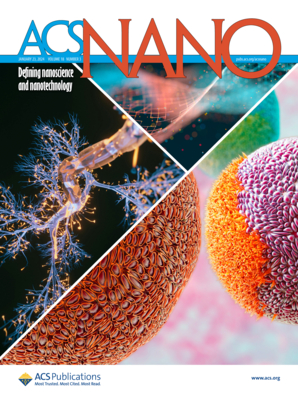将纳米晶体转化为超硬碳化硼纳米结构
IF 15.8
1区 材料科学
Q1 CHEMISTRY, MULTIDISCIPLINARY
引用次数: 0
摘要
碳化硼(B4+δC)具有轻质、难熔和出色的机械性能,因此作为一种结构材料具有很大的潜力。然而,由于碳化硼在受到外部应力时容易发生非晶化,其大规模工业化进程受到了阻碍。在本研究中,我们设计了一条通向硬度和抗非晶化能力大大增强的纳米结构碳化硼的途径。反应途径包括引发在熔盐中生成的 Na1-xB5-xC1+x (x = 0.18)共价纳米晶体的同构转变。与之前的研究相比,所得到的 10 纳米 B4.1C 纳米晶体的尺寸缩小了 4 倍。固态 11B 和 13C NMR 与密度泛函理论(DFT)的结合显示,碳化硼纳米晶体是由原子构型的复杂混合物组成的,这些原子构型位于 B11C 二十面体建筑单元之间的共价结构链上。这些纳米晶体与高压下的火花等离子烧结方法相结合。这样就能在保持粒度的同时实现完全致密化。纳米级的晶粒和高密度的晶界使纳米结构体的硬度和抗变质能力显著增强,从而提供了一种超硬材料。本文章由计算机程序翻译,如有差异,请以英文原文为准。

Transforming Nanocrystals into Superhard Boron Carbide Nanostructures
Boron carbide (B4+δC) possesses a large potential as a structural material owing to its lightness, refractory character, and outstanding mechanical properties. However, its large-scale industrialization is set back by its tendency to amorphize when subjected to an external stress. In the present work, we design a path toward nanostructured boron carbide with greatly enhanced hardness and resistance to amorphization. The reaction pathway consists of triggering an isomorphic transformation of covalent nanocrystals of Na1–xB5–xC1+x (x = 0.18) produced in molten salts. The resulting 10 nm B4.1C nanocrystals exhibit a 4-fold decrease of size compared to previous works. Solid-state 11B and 13C NMR coupled to density functional theory (DFT) reveal that the boron carbide nanocrystals are made of a complex mixture of atomic configurations, which are located at the covalent structural chains between B11C icosahedral building units. These nanocrystals are combined with a spark plasma-sintering-derived method operated at high pressure. This yields full densification while maintaining the particle size. The nanoscaled grains and high density of grain boundaries provide the resulting nanostructured bodies with significantly enhanced hardness and resistance to amorphization, thus delivering a superhard material.
求助全文
通过发布文献求助,成功后即可免费获取论文全文。
去求助
来源期刊

ACS Nano
工程技术-材料科学:综合
CiteScore
26.00
自引率
4.10%
发文量
1627
审稿时长
1.7 months
期刊介绍:
ACS Nano, published monthly, serves as an international forum for comprehensive articles on nanoscience and nanotechnology research at the intersections of chemistry, biology, materials science, physics, and engineering. The journal fosters communication among scientists in these communities, facilitating collaboration, new research opportunities, and advancements through discoveries. ACS Nano covers synthesis, assembly, characterization, theory, and simulation of nanostructures, nanobiotechnology, nanofabrication, methods and tools for nanoscience and nanotechnology, and self- and directed-assembly. Alongside original research articles, it offers thorough reviews, perspectives on cutting-edge research, and discussions envisioning the future of nanoscience and nanotechnology.
 求助内容:
求助内容: 应助结果提醒方式:
应助结果提醒方式:


